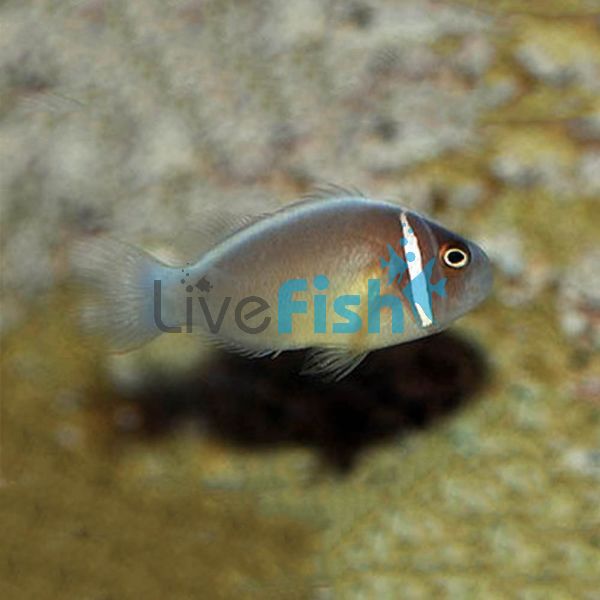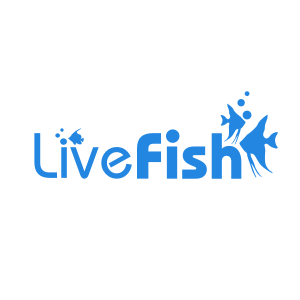Pink Skunk Clownfish - Large
The Pink Skunk Clownfish has a captivating personality. Its unique appearance and distinguishing skunk stripe make it a popular choice for aquarists.
The Pink Skunk Clownfish has magenta tipped fins and is a fuller reddish-pink colour. Pink Skunk Clownfish are considered semi-aggressive, but when compared to other varieties of clownfish they are relatively peaceful.
Pink Skunk Clownfish have a peachy pink body colour, with a white “skunk” stripe running down its body from the head to tail fin. There is also a vertical white stripe which is located behind the eye.
While is possible to breed Pink Skunk Clownfish in captivity, it is considered difficult. They start courting in the wild a few days before spawning. The male and female clean a rocky surface next to their anemone, where the eggs will be deposited. When the female is ready to spawn, she will swim with the male, their stomachs touching. She then presses her stomach against the cleaned rock and the male swims behind, fertilizing the eggs.
Male and female Pink Skunk Clownfish are similar in size. They can be distinguished by their fins; males have orange or pink around the edges while females have paler white fins.
In their natural environment, this species can be found in shallow reef areas and lagoons, usually between 3-30 meters. They aren’t particularly strong swimmers and prefer staying in areas of calmer water.
The common anemones that Pink Skunk Clownfish host in are the Magnificent Sea Anemone (Heteractis Magnifica), Sebae Anemone (Heteractis Crispa), Giant Carpet Anemone (Stichodactyla gigantea) and Long Tentacle Anemone (Macrodactyla doreensis).
It isn’t a necessity for clownfish to host anemones, but they are happy to do it in most circumstances. The Bubble Tip Anemone (Entacmaea quadricolor) is a suitable choice for an aquarium.
The natural habitat for this species is the Western Pacific, including the Great Barrier Reef & Tonga, Japans’ Ryuku Islands. They are also distributed across the Eastern Indian Ocean.
Tank Recommendations for the Pink Skunk Clownfish
The smallest tank size to keep these Clownfish is 30 gallons (114 litres).
Pink Skunk Clownfish can be introduced to both reef and fish-only aquariums. It is advisable to make sure there is an area of the tank with slow-moving water where they can feed.
A suitable tank environment should contain plenty of live rock with algae, so the clownfish can graze and use the rock for hiding or shelter.
Suitable Tank Buddies
Pink Skunks are one of the most peaceful clownfish varieties, but this can mean they can get harassed or bullied. As stressful environment can make them ill.
They can co-habit with most other docile fish, except for larger ones who may swallow them whole.
Usually Compatible
Suitable tank buddies for Pink Skunk Clownfish include Batfish, Damsels, Grunts/Sweetlips, Foxface/Rabbits, and Puffers. It is also possible to house them more peaceful clownfish such as the True Percula.
Sometime Compatible
Care should be taken if housing Pink Skunk Clownfish with other semi-aggressive fish. Certain types of Angels, Tangs and Wrasse might be too aggressive and cause stress. The situation is easier with semi-aggressive fish if the clownfish has an anemone to host.
Rarely Compatible
Avoid housing Pink Skunks with clownfish of the Maroon, Clarkii or Tomato variety. Dottybacks, 6 & 8 line Wrasse, Damsels, Lionfish, Eels, Groupers and Sharks/Rays are also unsuitable.
Feeding Your Pink Skunk Clownfish
The Pink Skunk Clownfish is omnivorous however in captivity it is recommended to place more emphasis on vegetable produce. They will eat algae in the tank, but if there isn’t enough available then spirulina can be included in the diet as a supplement. Flake foods and pellets containing spirulina are a suitable option.
A variety of meaty foods should also be included in the diet, such as brine and mysis shrimp, finely chopped fish, and crustacean flesh. Adults should be fed 2 times per day, juveniles 3-4 times per day.
| Scientific Name | Amphiprion perideraion |
|---|---|
| Care Level | Moderate |
| Common Names | Pink Skunk Clownfish, False Skunk-striped Anemonefish, Pink Anemonefish, False Skunk Striped Clown, White-maned Anemonefish, Salmon Clownfish and Whitebanded Anemonefish. |
| Diet | Omnivore |
| Fish Family | Pomacentridae |
| Lifespan (years) | 21 |
| Max. Length (cm) | 10 |
| Min. Tank Volume (l) | 114 |
| Origin | Western Pacific, including the Great Barrier Reef & Tonga, Japans’ Ryuku Islands. Eastern Indian Ocean |
| Reef Safe | Yes |
| Sociability | Semi-aggressive |
| Venomous | No |
| Water Conditions | 22 - 26°C (72-78° F), dKH 8-12, pH 8.1 - 8.4, sg 1.020-1.025 |




